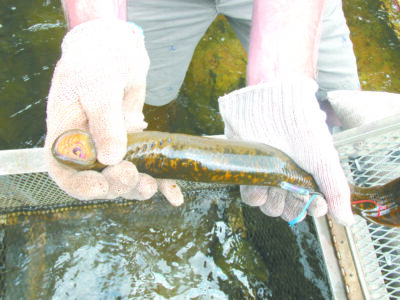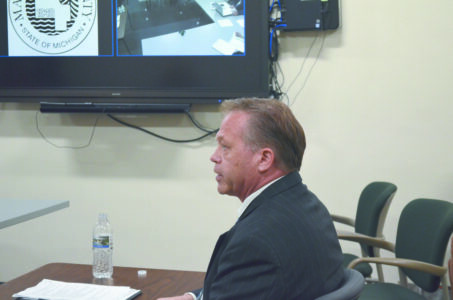CLEARING THE FOG:
30 years later, investigators say there’s new developments, still hope in unsolved Girard murder

Michigan State Police crime lab survey the area where the body of Paul Girard was found at Marquette's Presque Isle Park, Friday, Sept. 30, 1988. (Journal file photo by Dave Schneider)
MARQUETTE — Thirty years ago today, the largest criminal investigation ever conducted by the Marquette City Police began when 34-year-old Marquette resident Paul Girard was found brutally murdered near Chief Kawbawgam’s grave on Presque Isle Park in Marquette.
Girard’s body was discovered just after 10 a.m. on Sept. 30, 1988, by two people who were walking around the island — police found Girard had been murdered sometime in the early morning hours of Sept. 30, suffering dozens of stab wounds at the hands of an assailant.
It was the “most violent crime scene” ever witnessed by Sal Sarvello, who was captain of detectives at the Marquette City Police at that time and retired as chief in 2001 after 30 years with the Marquette police.
“The amount of stab wounds says this is somebody who wanted to end his life immediately,” said Hank Steede, who became the main detective on the case in 1988 and investigated the case until his retirement 10 years later.
Sarvello, Steede and many others responded to the scene that fateful morning and began investigating the scene, collecting evidence, taking photographs, and trying to piece together what had happened in the hours prior.
In the decades following, investigators with local, state and federal agencies have searched tirelessly for answers — and the physical evidence or confession that will definitively link a person to the murder.
Today, the investigation is being actively pursued by Detective Sergeant Doug Heslip of the Marquette City Police Department, in hopes of “lifting the fog” surrounding the 30-year-old unsolved murder case.
“I’ve been going out and turning stones over, trying to develop information on this case,” Heslip said.
While one person has been a suspect since the spring of 1989, Heslip has uncovered new information during his two years on the case, which has led to the development of two additional people of interest in the investigation.
“The original suspect is still on the radar, along with a couple other people that I’ve developed since I’ve been working on it,” he said.
In hopes of finding definitive physical evidence that links a person of interest to Girard’s murder — or eliminates them as a suspect — Heslip has executed two search warrants within the last year and worked with the Michigan State Police Crime Lab to process evidence found at the crime scene with new forensic technology.
“I’ve used blood spatter experts, I’ve used biometrics, I’ve used latent prints. Some of this stuff wasn’t available in ’88 and I’m taking advantage of what I can take advantage of scientifically,” Heslip said, noting DNA testing has also been utilized.
Heslip is still waiting on results, but has been using any resource he can to solve the case. He is grateful for these resources, crediting the assistance of the Michigan State Police Crime Lab and “full support” of Marquette City Police Chief Blake Rieboldt in his investigation.
He is also thankful for the hard work and ongoing support of the original investigators, saying “they gave it their all” during their time on the case.
Steede and Sarvello, who originally investigated the case, said they did everything they could and still hope deeply for a resolution.
“During the course of this, we did everything possible to get to the bottom of this, including consulting with criminal profilers from the FBI who took a look at this case with us to see if there was anything more we could do,” Sarvello said. “We sought out anyone who could help us.”
Police worked tirelessly to try to solve the case, but felt they had hit a “dead end” after months of investigation — until a person of interest was developed in April 1989, Sarvello said.
“We received information from a state police detective who had an informant who gave him the name of the suspect for us to look at,” Sarvello said.
The lead seemed promising, as the tip indicated this suspect had told someone they were responsible for Girard’s murder, Steede said. Police conducted interviews, but there was not enough information to arrest the person or bring charges against them and a confession was never made.
“We were never able to develop that to a point where we could bring him to trial because basically, it was just him saying he had done it — we didn’t have any physical evidence, anything we could use to take him into court,” Steede said.
Over the course of the next 30 years, hundreds of people would be interviewed, a wide variety of forensic techniques would be deployed, and many stones would be overturned in hopes of solving the case.
The murder weapon was never found. Two additional people of interest have been developed throughout Heslip’s investigation, but have yet to be definitively linked or cleared. There was blood found at the scene that was not Girard’s, but the blood has not been matched to anyone. And whether or not Girard’s killer had known him or not remains the “million dollar question,” Heslip said.
“The longer it goes, the more you realize that you just need that one somebody who’s going to tell you that one piece of information that’s going to tip the scale,” Steede said.
The motivation for the crime and exactly what took place in the early morning hours of Sept. 30, 1988, still remain a mystery to investigators, despite their efforts and the construction of a detailed timeline of events.
However, then, and now, police have considered the possibility that Girard’s sexuality may have had something to do with the crime, as Girard was an openly gay man — today, the incident may have been categorized as a “hate crime.”
The unsolved murder case has frustrated investigators for years, they said, but remain open to all possibilities and are hopeful that the case can still be solved through Heslip’s investigation.
“You get a prime suspect, but you’re always still open to the what ifs,” Steede said.
Now, police are still waiting for the person, or piece of physical evidence that will solve the case once and for all — and they believe the information they need is out there.
“There’s a person in town that has knowledge of this crime because he was told about it by the suspect but he won’t cooperate,” Sarvello said.
Heslip encourages anyone who may have information — no matter how seemingly insignificant — to come forward, as they might just have the missing piece of the puzzle.
“If there’s somebody out there that is afraid to talk, now is the time to do it, they need to come in and tell me what they know,” Heslip said. “No matter how minor it is, it might be jiving with what I’m doing right now.”
Heslip dearly wants to solve the case and provide closure for Girard’s loved ones, as well as investigators who had previously worked the case.
“I look forward every day to coming to work and working on this case. I consider it a one-on-one battle with this guy and I want to get closure,” he said.
All parties involved, past and present, have been deeply invested in solving the crime, they said.
“I would have given anything to have this cleaned up before I retired,” Sarvello said.
The case has always been of great importance to investigators, Steede said, noting that “it was a case that haunted me and bothered me and I wanted to resolve it.”
“He was a member of a family, he had coworkers, just like everybody else, and his life was taken from him,” he said.
In the mind of Heslip and the case’s former investigators, Girard’s murder will never be forgotten.
“I think about it when I leave work, I think about it on the weekends, I think about it when I’m on vacation,” Heslip said. “I constantly think about it and I just hope that through science and investigative work we find out who did this.”
As Heslip continues to investigate and awaits information from search warrants and forensic testing, he wants the people of Marquette to know the Marquette City Police are working hard at this case — and there’s still hope for a resolution, 30 years later.
Anyone with information on this case is asked to contact the Marquette City Police at 906-228-0400.
Cecilia Brown can be reached at 906-228-2500, ext. 248. Her email address is cbrown@miningjournal .net.






